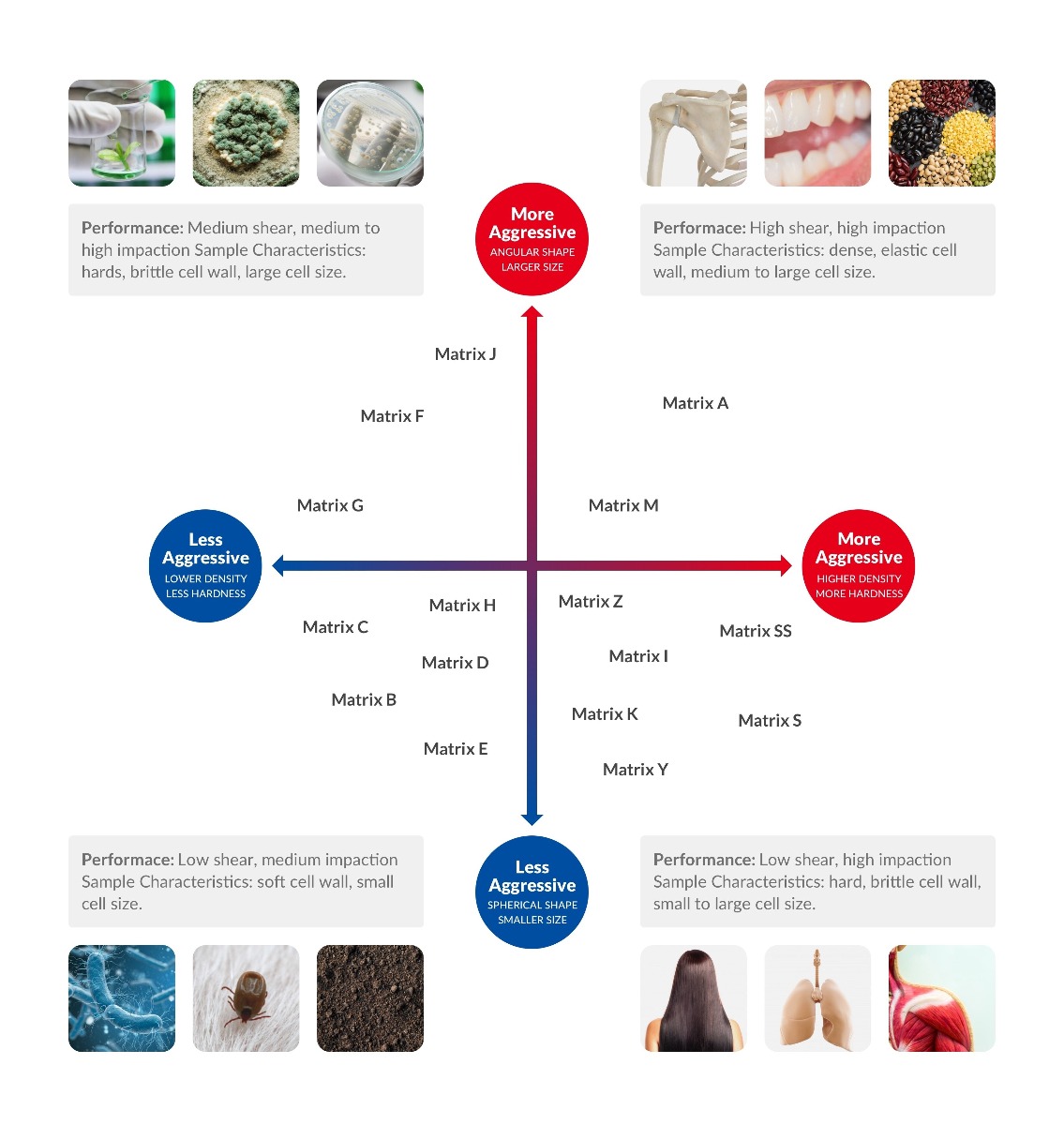Bead Beating Lysing Matrix Characteristics
Lysing matrix refers to the physical beads used to mechanically lyse and homogenize samples. Lysing matrices differ by size, shape, material, and composition. When selecting the appropriate beads, consider your sample type, the desired particle size you wish to obtain, and the stability (or vulnerability to degradation) of your target molecule.
Size Matters:You should select the matrix bead size based on the particle size you aim to obtain in your lysate. The smaller the beads used in the lysing matrix, the smaller the average particle size within the sample produced from disruption. Bead sizes range from microns to centimeters, and the range can vary depending on the bead material. In some cases, multiple sizes may be necessary to get the desired pulverization.
Lysing Bead Shape Dictates How Cells Are DisruptedBead shape determines how cells are disrupted and influences how aggressive the lysing and homogenization process is. Lysing beads are classified as spherical—utilizing impaction and hammering as the leading force—and angular—generating mechanical shear forces to chop and cut samples.
Choose the lysing bead shape based on your sample type and specific application. Angular shaped matrices, such as satellites, are sharp and can quickly lyse and grind challenging samples, such as difficult-to-disrupt cell walls and fibrous tissue. While shear force is ideal for isolating stable molecules, such as DNA and small molecules, dull, spherical matrices are preferable for isolating organelles or unstable molecules, such as RNA and specific proteins.
Material: Tough Samples Need Hard BeadsSeveral different types of materials are available for cell disruption, and each has advantages and disadvantages. The lysing beads' material determines density, hardness, durability, and chemical resistance, which influence lysis efficiency and the integrity of target analytes. The lysing bead's hardness must be greater than the sample, with higher hardness being more effective for pulverizing hard and brittle cell membranes. Individual bead types are sufficient to lyse some samples, but more challenging samples may require a combination of bead materials.
- Silica – This is the least dense, least hard material and is generally spherical and smaller than other bead material types, making it the least aggressive. Silica is primarily used for disrupting microorganisms.
- Ceramic – It is higher in density and strength than silica and is chemically inert, so it will not bind nucleic acids. It is appropriate for soft animal tissues, plant tissue, and whole insects.
- Silicon Carbide – A relatively low density and high strength and hardness, making it useful for disrupting tough, hard, or brittle cell membranes. This material is practical for isolating intact organelles, super-molecular structures, RNA, and protein, where lysis conditions require high impaction but low shearing.
- Glass – A low durability and density material, but widely used due to low cost. It is inert but can be modified or derivatized using silane chemistry. Glass beads can be used in combination with other bead materials to reduce shearing intensity.
- Zirconium Silicate – This is higher in density than glass but lower than stainless steel and zirconium oxide. It can be partially modified or derivatized using silane chemistry.
- Zirconium Oxide – A material with high density, durability, and hardness. It can break very tough and hard samples, including organisms with a dense exterior matrix. To increase hardness, density, and durability, zirconium oxide beads can be yttria-stabilized or ceria-stabilized.
- Stainless Steel – The hardest and most dense of all material types, generating high impaction with minimal shearing—making stainless steel beads and balls suitable for RNA extraction from difficult samples. A disadvantage is that they may react with phenol and acids, which might interfere with sample processes.
- Garnet – Garnet matrix is highly aggressive, making it very effective for DNA isolation but potentially too harsh for RNA and protein isolation applications. It is chemically inert and will not bind nucleic acids. In combination with zirconium, it can lyse almost any sample.
A combination of grinding media sizes, shapes, and materials within a single sample can help optimize cell disruption. There are some high-quality, ready-to-use products available on the market. For instance, MP Bio offers a wide variety of lysing beads and matrices and the BiopulverizerTM Lysing Matrix Set optimized to rapidly provide the highest yields of nucleic acids and proteins from any sample type and application while avoiding cross-contamination.
Lysing Matrices
Get reproducible homogenization with MP Bio's bead beating tubes and ready-to-use lysing matrices for any sample type.
View Products





